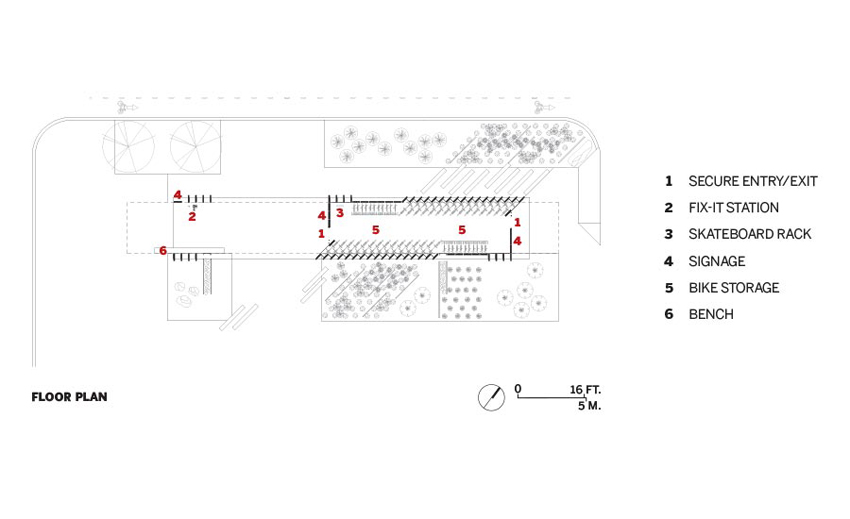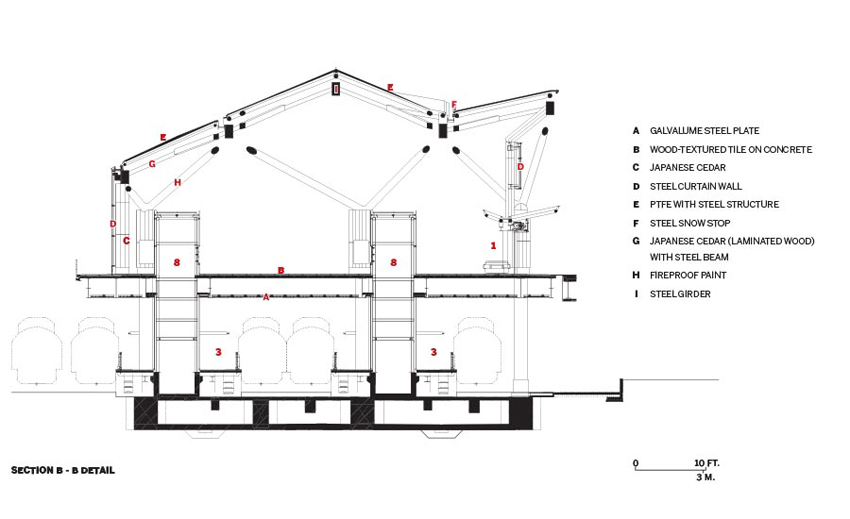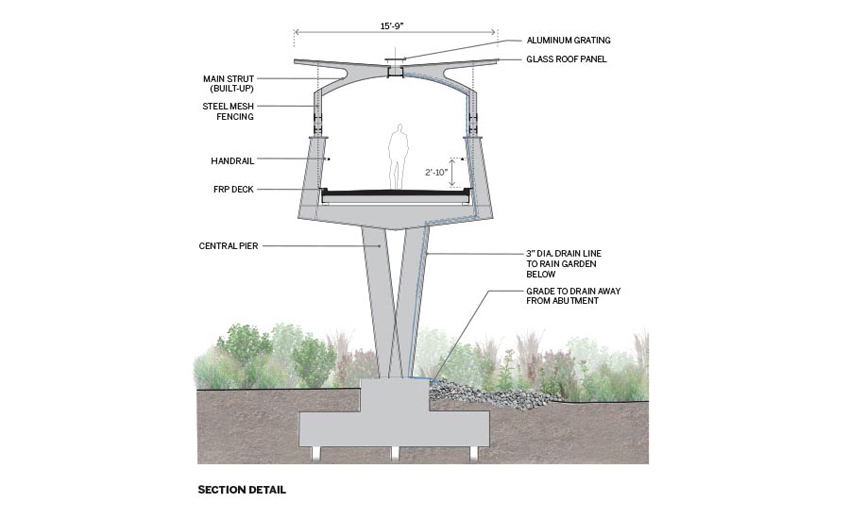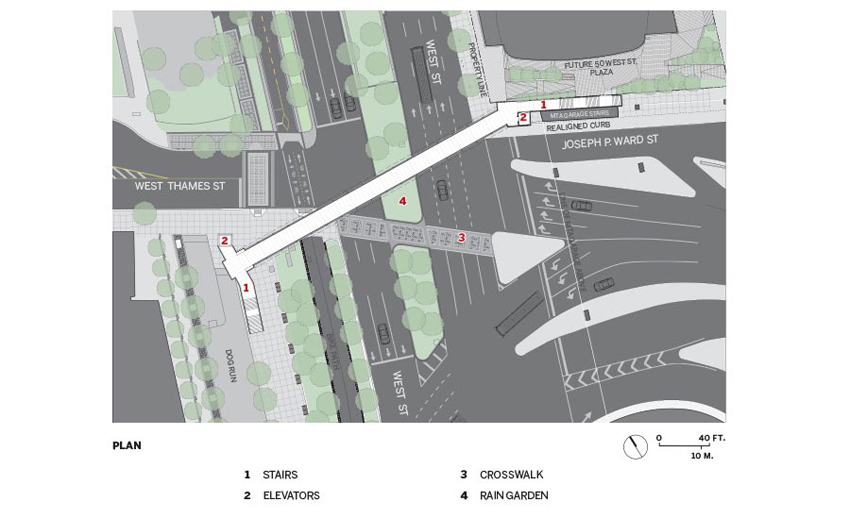THE VIBRANT CITY of Stuttgart has long been a strategic commercial hub, nestled in southwest Germany and home to companies such as Bosch, Mercedes-Benz, and Porsche. Its rail infrastructure is vital to local and regional mobility, and a major upgrade has been planned since the early 1990s. Stuttgart21, as it is called, includes four new stations, 40 miles of tunnels, and 44 bridges at a cost of $9.75 billion. The centerpiece is the new main station, designed by Christoph Ingenhoven (founder of Düsseldorf-based Ingenhoven Architects) with the late Frei Otto, the 2015 Pritzker Prize laureate known for his experiments with lightweight structures. The team was chosen after a competition in 1997.
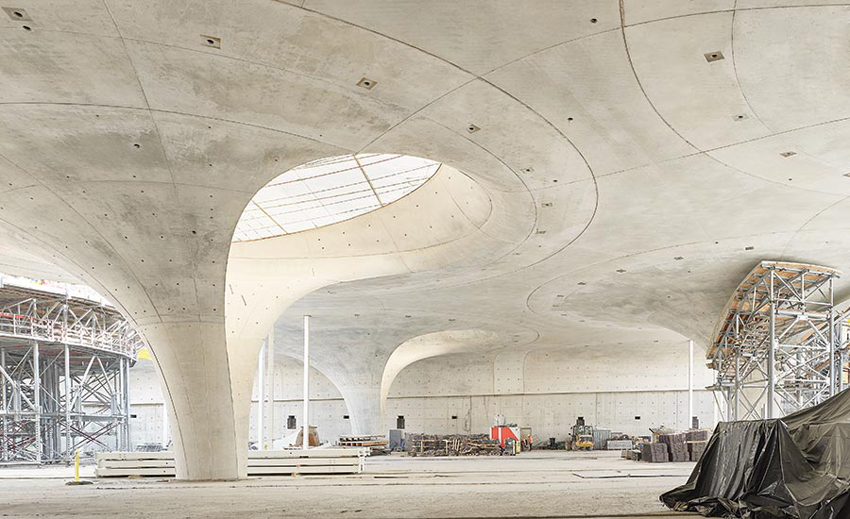
PHOTOGRAPHY: © ACHIM BIRNBAUM
THE DEFINING element of the station will be delicately unfurling cast-in-place chalice-shaped columns.
The brief was challenging. Stuttgart’s inner city is oriented roughly north–south in a valley, with an existing terminus train station at its northern tip. The Neo-Romanesque edifice by Bonatz and Scholer, completed in 1928, has 16 aboveground tracks, and the competition called for creating a through station with half as many tracks, rotated 90 degrees from the existing ones and sunk below grade through new rail tunnels parallel to the northern facade of the old station. The realignment will shorten travel and transfer times, allow for a direct airport connection, and locate Stuttgart on a Paris-to-Budapest rail link. After completion, in 2025, the aboveground tracks will be replaced with a residential district for 10,000 inhabitants.
Ingenhoven and Otto were an unusual pairing. At the time of the competition, Ingenhoven was launching his career with large buildings that featured innovative approaches to sustainability, such as the 1996 RWE Tower in Essen, while Otto was the acknowledged pioneer of lightweight tensile structures. Previously, they had collaborated on a scheme for an ecological skyscraper, the Commerzbank Tower in Frankfurt-am-Main, a commission that ultimately went to Sir Norman Foster. For Stuttgart21, Otto’s role was scientific support for development, design, construction, and structure.
To enclose the below-grade tracks and expand the station, the architects rejected a tall structure, noting that cool air from the surrounding hills falls to the valley at night, and a high building would inhibit this flow. They proposed a low, naturally illuminated station hall, measuring 1,475 feet by 260 feet, with several entrances at the shorter sides. Above, a new plaza and park would be a part of continuous 10-acre public area.
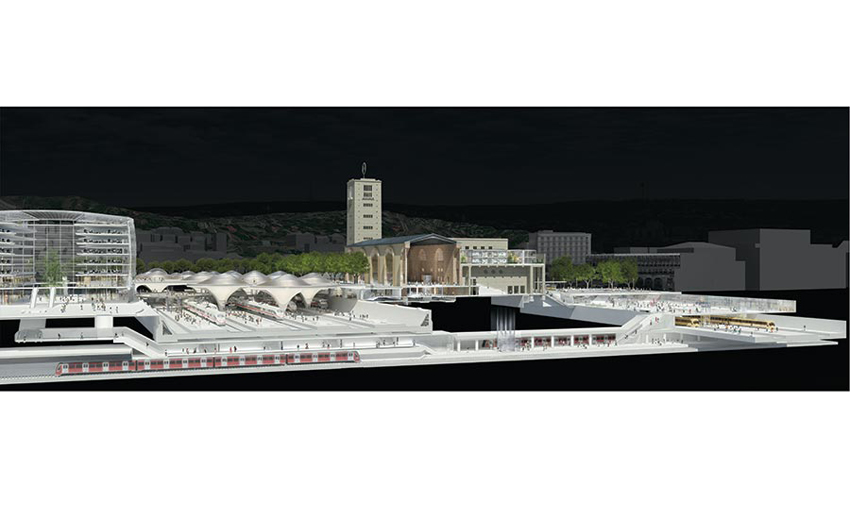
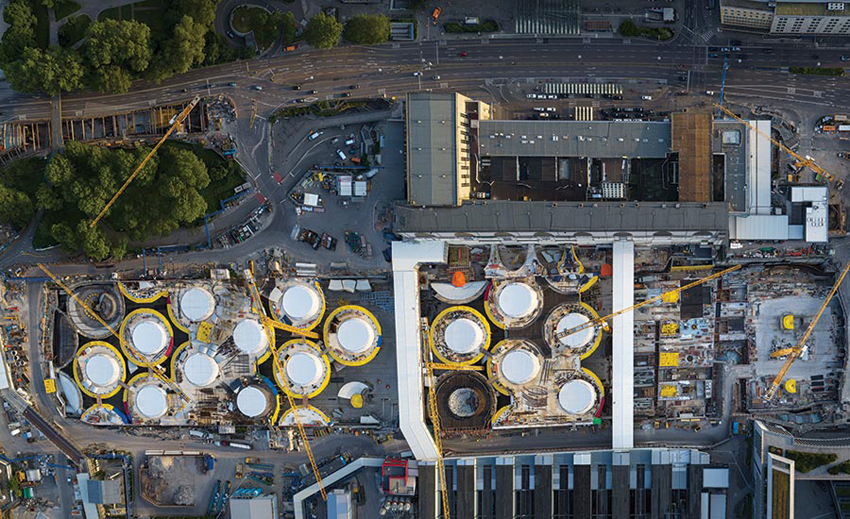
IMAGES: © INGENHOVEN ARCHITECTS (TOP); HG ESCH (BOTTOM)
THE AMBITIOUS project includes submerging tracks below level under a roof supported by 28 of the distinctive columns (top), about half of which have been completed (bottom).
Experimenting with plaster and tensile-skin models, they designed a structure that appears both dynamic and transcendent. A field of giant oculi, angled to face south, cover the roof. On the interior, the bottom rim of each oculus stretches down to form a column, directing a cascade of natural light along its surface. Due to the immense loads, the scheme was developed for reinforced concrete, with engineering by Büro Ted Happold (Berlin) and Leonhardt, Andrä and Partners (Stuttgart). And, though the original train station was a protected monument, the design called for retaining only its main section and tower, for offices, shops, and an entrance, while its north and south wings were to be demolished.
The project initially languished, finding renewed impetus in the early 2000s. In 2009, Frei Otto left the team (he died in 2015). In the same year, the Stuttgart-based Werner Sobek—who has conducted research on lightweight materials with minimal structure, and with a computer-assisted design approach integrating architecture, engineering, and sustainability—became the chief engineer.
But more obstacles and controversy lay ahead. Demonstrations against Stuttgart21, which had been taking place for years, gained momentum, with protestors decrying the high costs, the years-long inner-city construction site, potential environmental damage, and the partial demolition of the original station, among other issues. In late September 2010, the conflict escalated; after the police used pepper spray and water cannons to clear peaceful protestors who were blocking the tunnel construction, the public was outraged. Not long after, in scheduled elections, the regional government, led by the Christian Democrats, who supported the project, was voted out and replaced by a coalition headed by the Greens, who were opponents. A referendum in November 2011, however, was decided in favor of continuing Stuttgart21. Ironically, the current regional government, with the Greens in charge, is overseeing the station’s completion.
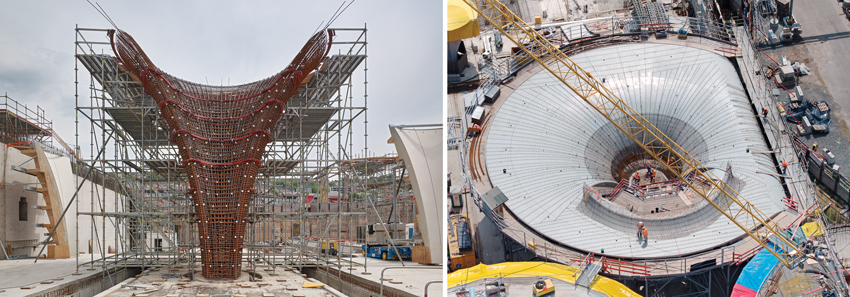
IMAGES: ACHIM BIRNBAUM (OPPOSITE)
THE REBARS, up to 32,000 of them in a single column, are precisely placed via a digital model and laser projection (left). Resin-coated formwork helps produce the desired concrete surface (right).
The polarization and unrest put additional strain on those developing the project for construction. The greatest challenge, says Sobek, “was the extremely high level of geometric complexity of the calculations that were being carried out while the very negative public reception to the project was at its height.”
Soon, this tumultuous period may fade from memory, replaced with awe at the station’s arresting interior. In February 2021, ceremonies celebrated the completion of half of the 28 delicately unfurling, chalice-like reinforced-concrete columns. Along with the two 1,475-foot-long, 19½-foot-high reinforced-concrete side walls, the columns support the station roof, which is designed as a reinforced jointless shell with variable thickness, depending on the strain. The columns are narrow at the base and expand upward like a finely sculpted cone, with a convex southeastern side and concave northwestern one. At the roof, they have a diameter of 100 feet, half of which is taken up by the round, angled skylight, now called a Lichtauge, or light eye.

IMAGES: © ACHIM BIRNBAUM (LEFT); INGENHOVEN ARCHITECTS (RIGHT)
SOUTH-FACING circular skylights called Lichtaugen, or light eyes, top each column, contributing to the station’s zero energy concept (left and right).
Varying in height from 30 feet to 39 feet, each column is unique due to its location and performance, and 3-D digital models were employed to optimize and calculate the forms. Their aesthetic and structural demands necessitated a reversal of typical construction methods. Each column requires between 22,000 to 32,000 rebars, which are fabricated in a special facility in Esslingen, transported to the site, and then precisely configured to describe the chalice-like form. Their positions are controlled via laser projection, which compares the positions of the rebars to a digital model of the reinforcements. Then the rebars are enclosed in custom-built wood formwork. To achieve a nonporous and joint-free surface, the forms are coated with specially developed resins; they are also recycled for various positions on the site. During the pouring, a moderate use of vibrators and a highly fluid concrete mixture insures that any voids and the areas around the dense rebars are reached. Per column, the construction time is three months, requiring 750 tons of concrete and 350 tons of steel reinforcement.
A special concrete mixture consisting of white cement, granulated slag (a by-product of iron manufacture), and fine plastic fibers was developed to satisfy the columns’ complex geometry and the fire-protection regulations for exposed concrete. When poured, the material has a dull pewter hue, but after it oxidizes, the surface lightens “and becomes the luminous train station that we all desire,” says Ingenhoven.
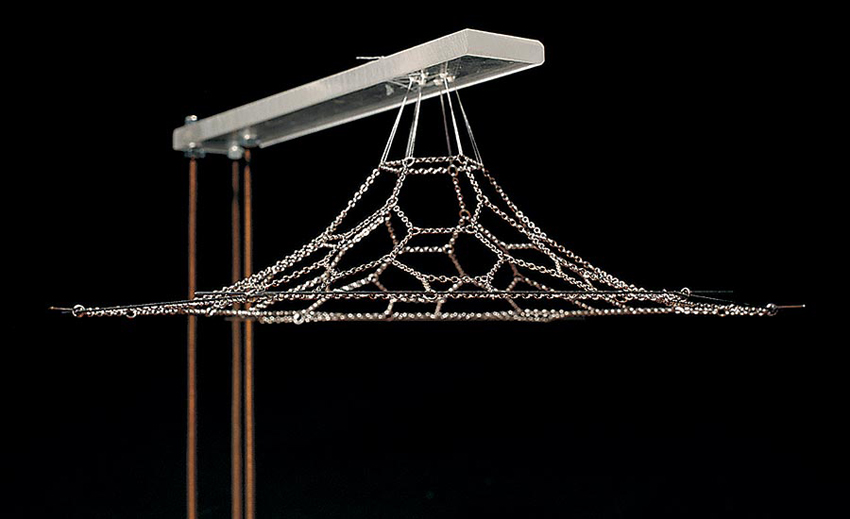
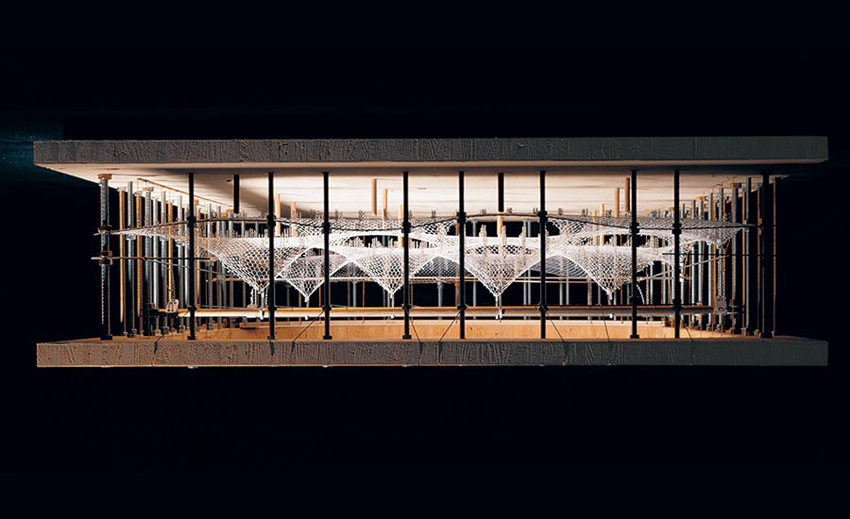
IMAGES: HOLGER KNAUF
EXPERIMENTATION with tensile structure and physical models (top and bottom) informed the columns’ chalice shape.
The columns also contribute to the station’s “zero energy” concept, meaning electricity is not required for ventilation, heating, or basic lighting. During the day, the Lichtaugen illuminate the station’s interior; at night, the concrete’s pearly white surface reflects the luminaires on the tracks. Meanwhile, the movement of the trains brings air from the tunnels, where there is a constant temperature of 62 degrees Fahrenheit, into the station. The moderating effect of the massive construction and the below-grade location will keep temperatures between 50 and 77 degrees Fahrenheit, while louvres in the Lichtaugen provide ventilation. Solar panels on the roof of the old station will supply some electricity for signage, supplemental lighting, and elevators and escalators.

IMAGE: INGENHOVEN ARCHITECTS
A PARK above the station will be part of a continuous 10-acre public area.
With completion of the new Stuttgart main train station scheduled for 2025, a cautious optimism pervades: “It is like halftime in soccer,” says Ingenhoven. “We are leading with 2 goals to 0, but we still have a long, difficult path ahead. There is still a lot of exciting stuff to come.”
Mary Pepchinski is a writer, curator, and educator based in Berlin.

IMAGES: HG ESCH
Credits
Architect: Ingenhoven Architects — Christoph Ingenhoven, Klaus Frankenheim, Hinrich Schumacher, Michael Rathgeb, Bjørn Polzin, Dr. Dieter Henze, Peter Pistorius, Martin Gehrmann, Jascha Klusen, Huub Donkers, Matej Ferenc, Anemone Ingenhoven-Feld, Victor Braun, Vanessa García Carnicero, Elvan Urungu, Peter Georg Vahlhaus, Pavlos Antoniou, Julian Blönnigen (project team)
Consultants: Werner Sobek, Engineering Consortium Tragwerks-planung S21, Leonhardt, Andrä and Partners, Happold Engineering (structure); Drees & Sommerv, NEK Ingenieure, HL-Technik Consulting Engineers (mechanical services); Tropp Lighting Design (lighting); IFI Institute for Industrial Aerodynamics (airflow); Smoltczyk & Partner (geotechnical); Drees & Sommer (building physics); BPK Fire Safety Consultants (fire protection)
General Contractor: Zublin (core and shell)
Client: Deutsche Bahn
Size: 2 million square feet
Cost: withheld
Completion date: 2025
View course on architecturalrecord.com »
As the vital arteries that connect people and places within and beyond metropolitan areas, transportation hubs are the lifeblood of urban centers. On the pages ahead, RECORD explores imaginative solutions for such infrastructure, from an elegant pedestrian bridge in Lower Manhattan to an ongoing megaproject transforming Stuttgart’s central rail station and the heart of the city. Despite the range in scale, these architecturally inventive projects enhance the appeal of getting from point A to point B by train, bus, bike, or on foot. Reading about them and taking the online quiz earns one hour of continuing-education credit.

PHOTOGRAPHY: © YU_PHOTO/ SHUTTERSTOCK.COM
Takanawa Gateway station, Tokyo Kengo Kuma and Associates
THE VIBRANT CITY of Stuttgart has long been a strategic commercial hub, nestled in southwest Germany and home to companies such as Bosch, Mercedes-Benz, and Porsche. Its rail infrastructure is vital to local and regional mobility, and a major upgrade has been planned since the early 1990s. Stuttgart21, as it is called, includes four new stations, 40 miles of tunnels, and 44 bridges at a cost of $9.75 billion. The centerpiece is the new main station, designed by Christoph Ingenhoven (founder of Düsseldorf-based Ingenhoven Architects) with the late Frei Otto, the 2015 Pritzker Prize laureate known for his experiments with lightweight structures. The team was chosen after a competition in 1997.

PHOTOGRAPHY: © ACHIM BIRNBAUM
THE DEFINING element of the station will be delicately unfurling cast-in-place chalice-shaped columns.
The brief was challenging. Stuttgart’s inner city is oriented roughly north–south in a valley, with an existing terminus train station at its northern tip. The Neo-Romanesque edifice by Bonatz and Scholer, completed in 1928, has 16 aboveground tracks, and the competition called for creating a through station with half as many tracks, rotated 90 degrees from the existing ones and sunk below grade through new rail tunnels parallel to the northern facade of the old station. The realignment will shorten travel and transfer times, allow for a direct airport connection, and locate Stuttgart on a Paris-to-Budapest rail link. After completion, in 2025, the aboveground tracks will be replaced with a residential district for 10,000 inhabitants.
Ingenhoven and Otto were an unusual pairing. At the time of the competition, Ingenhoven was launching his career with large buildings that featured innovative approaches to sustainability, such as the 1996 RWE Tower in Essen, while Otto was the acknowledged pioneer of lightweight tensile structures. Previously, they had collaborated on a scheme for an ecological skyscraper, the Commerzbank Tower in Frankfurt-am-Main, a commission that ultimately went to Sir Norman Foster. For Stuttgart21, Otto’s role was scientific support for development, design, construction, and structure.
To enclose the below-grade tracks and expand the station, the architects rejected a tall structure, noting that cool air from the surrounding hills falls to the valley at night, and a high building would inhibit this flow. They proposed a low, naturally illuminated station hall, measuring 1,475 feet by 260 feet, with several entrances at the shorter sides. Above, a new plaza and park would be a part of continuous 10-acre public area.


IMAGES: © INGENHOVEN ARCHITECTS (TOP); HG ESCH (BOTTOM)
THE AMBITIOUS project includes submerging tracks below level under a roof supported by 28 of the distinctive columns (top), about half of which have been completed (bottom).
Experimenting with plaster and tensile-skin models, they designed a structure that appears both dynamic and transcendent. A field of giant oculi, angled to face south, cover the roof. On the interior, the bottom rim of each oculus stretches down to form a column, directing a cascade of natural light along its surface. Due to the immense loads, the scheme was developed for reinforced concrete, with engineering by Büro Ted Happold (Berlin) and Leonhardt, Andrä and Partners (Stuttgart). And, though the original train station was a protected monument, the design called for retaining only its main section and tower, for offices, shops, and an entrance, while its north and south wings were to be demolished.
The project initially languished, finding renewed impetus in the early 2000s. In 2009, Frei Otto left the team (he died in 2015). In the same year, the Stuttgart-based Werner Sobek—who has conducted research on lightweight materials with minimal structure, and with a computer-assisted design approach integrating architecture, engineering, and sustainability—became the chief engineer.
But more obstacles and controversy lay ahead. Demonstrations against Stuttgart21, which had been taking place for years, gained momentum, with protestors decrying the high costs, the years-long inner-city construction site, potential environmental damage, and the partial demolition of the original station, among other issues. In late September 2010, the conflict escalated; after the police used pepper spray and water cannons to clear peaceful protestors who were blocking the tunnel construction, the public was outraged. Not long after, in scheduled elections, the regional government, led by the Christian Democrats, who supported the project, was voted out and replaced by a coalition headed by the Greens, who were opponents. A referendum in November 2011, however, was decided in favor of continuing Stuttgart21. Ironically, the current regional government, with the Greens in charge, is overseeing the station’s completion.

IMAGES: ACHIM BIRNBAUM (OPPOSITE)
THE REBARS, up to 32,000 of them in a single column, are precisely placed via a digital model and laser projection (left). Resin-coated formwork helps produce the desired concrete surface (right).
The polarization and unrest put additional strain on those developing the project for construction. The greatest challenge, says Sobek, “was the extremely high level of geometric complexity of the calculations that were being carried out while the very negative public reception to the project was at its height.”
Soon, this tumultuous period may fade from memory, replaced with awe at the station’s arresting interior. In February 2021, ceremonies celebrated the completion of half of the 28 delicately unfurling, chalice-like reinforced-concrete columns. Along with the two 1,475-foot-long, 19½-foot-high reinforced-concrete side walls, the columns support the station roof, which is designed as a reinforced jointless shell with variable thickness, depending on the strain. The columns are narrow at the base and expand upward like a finely sculpted cone, with a convex southeastern side and concave northwestern one. At the roof, they have a diameter of 100 feet, half of which is taken up by the round, angled skylight, now called a Lichtauge, or light eye.

IMAGES: © ACHIM BIRNBAUM (LEFT); INGENHOVEN ARCHITECTS (RIGHT)
SOUTH-FACING circular skylights called Lichtaugen, or light eyes, top each column, contributing to the station’s zero energy concept (left and right).
Varying in height from 30 feet to 39 feet, each column is unique due to its location and performance, and 3-D digital models were employed to optimize and calculate the forms. Their aesthetic and structural demands necessitated a reversal of typical construction methods. Each column requires between 22,000 to 32,000 rebars, which are fabricated in a special facility in Esslingen, transported to the site, and then precisely configured to describe the chalice-like form. Their positions are controlled via laser projection, which compares the positions of the rebars to a digital model of the reinforcements. Then the rebars are enclosed in custom-built wood formwork. To achieve a nonporous and joint-free surface, the forms are coated with specially developed resins; they are also recycled for various positions on the site. During the pouring, a moderate use of vibrators and a highly fluid concrete mixture insures that any voids and the areas around the dense rebars are reached. Per column, the construction time is three months, requiring 750 tons of concrete and 350 tons of steel reinforcement.
A special concrete mixture consisting of white cement, granulated slag (a by-product of iron manufacture), and fine plastic fibers was developed to satisfy the columns’ complex geometry and the fire-protection regulations for exposed concrete. When poured, the material has a dull pewter hue, but after it oxidizes, the surface lightens “and becomes the luminous train station that we all desire,” says Ingenhoven.


IMAGES: HOLGER KNAUF
EXPERIMENTATION with tensile structure and physical models (top and bottom) informed the columns’ chalice shape.
The columns also contribute to the station’s “zero energy” concept, meaning electricity is not required for ventilation, heating, or basic lighting. During the day, the Lichtaugen illuminate the station’s interior; at night, the concrete’s pearly white surface reflects the luminaires on the tracks. Meanwhile, the movement of the trains brings air from the tunnels, where there is a constant temperature of 62 degrees Fahrenheit, into the station. The moderating effect of the massive construction and the below-grade location will keep temperatures between 50 and 77 degrees Fahrenheit, while louvres in the Lichtaugen provide ventilation. Solar panels on the roof of the old station will supply some electricity for signage, supplemental lighting, and elevators and escalators.

IMAGE: INGENHOVEN ARCHITECTS
A PARK above the station will be part of a continuous 10-acre public area.
With completion of the new Stuttgart main train station scheduled for 2025, a cautious optimism pervades: “It is like halftime in soccer,” says Ingenhoven. “We are leading with 2 goals to 0, but we still have a long, difficult path ahead. There is still a lot of exciting stuff to come.”
Mary Pepchinski is a writer, curator, and educator based in Berlin.

IMAGES: HG ESCH
Credits
Architect: Ingenhoven Architects — Christoph Ingenhoven, Klaus Frankenheim, Hinrich Schumacher, Michael Rathgeb, Bjørn Polzin, Dr. Dieter Henze, Peter Pistorius, Martin Gehrmann, Jascha Klusen, Huub Donkers, Matej Ferenc, Anemone Ingenhoven-Feld, Victor Braun, Vanessa García Carnicero, Elvan Urungu, Peter Georg Vahlhaus, Pavlos Antoniou, Julian Blönnigen (project team)
Consultants: Werner Sobek, Engineering Consortium Tragwerks-planung S21, Leonhardt, Andrä and Partners, Happold Engineering (structure); Drees & Sommerv, NEK Ingenieure, HL-Technik Consulting Engineers (mechanical services); Tropp Lighting Design (lighting); IFI Institute for Industrial Aerodynamics (airflow); Smoltczyk & Partner (geotechnical); Drees & Sommer (building physics); BPK Fire Safety Consultants (fire protection)
General Contractor: Zublin (core and shell)
Client: Deutsche Bahn
Size: 2 million square feet
Cost: withheld
Completion date: 2025
IT IS ONE of the great joys of train travel to pop up on arrival right in the city center. This is especially true compared with the taxi queues and suburban drear of arrival by air. But it brings an inevitable conundrum, since, even as it connects, any central station acts as a great blockage in the city’s heart. In Sydney, for the last century or so, this has been particularly pronounced. Now the new, $716 million adaptation of Central Station by Sydney’s Woods Bagot and London’s John McAslan + Partners (JMP), led by contractor Laing O’Rourke, is moving toward a remedy, set to open in 2024.
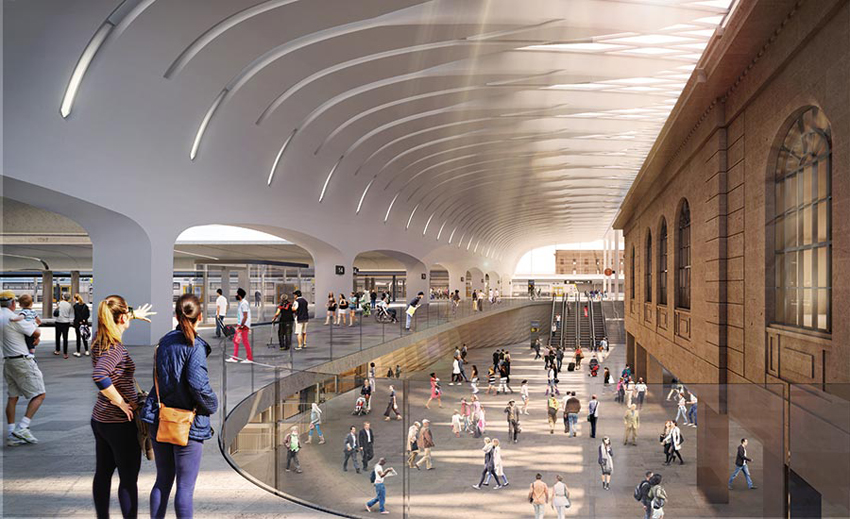
IMAGE: © JOHN MCASLAN + PARTNERS AND WOODS BAGOT
A LOFTY URBAN room has been created between the new metro and the historic station with a roof that cantilevers 115 feet.
Inner Sydney occupies a narrow peninsula jutting into Sydney Harbor. Central Station was built quite late, in 1906, at the southern, landward end of that peninsula. This enchanting water-encircled topography ensured the city’s success yet hampered its expansion. To the north, Sydney built its famous Harbour Bridge (opened in 1932), and other bridges east and west. But the major land connection was south, and Central was in the way.
Exacerbating the impediment was the colony’s largest brewery, dating from the early 1800s and directly adjacent. Both the brewery and the station had been built on swampy ground that, previously spurned for other uses, had contained a cemetery, a parsonage, a police barracks, a morgue, a gallows, and a convent. Fast-forward to this century, when the disused brewery was transformed into Central Park Sydney, a mixed-use complex that includes a garden-clad tower by Jean Nouvel (RECORD, February 2015) as part of its elegant, street-connected master plan.
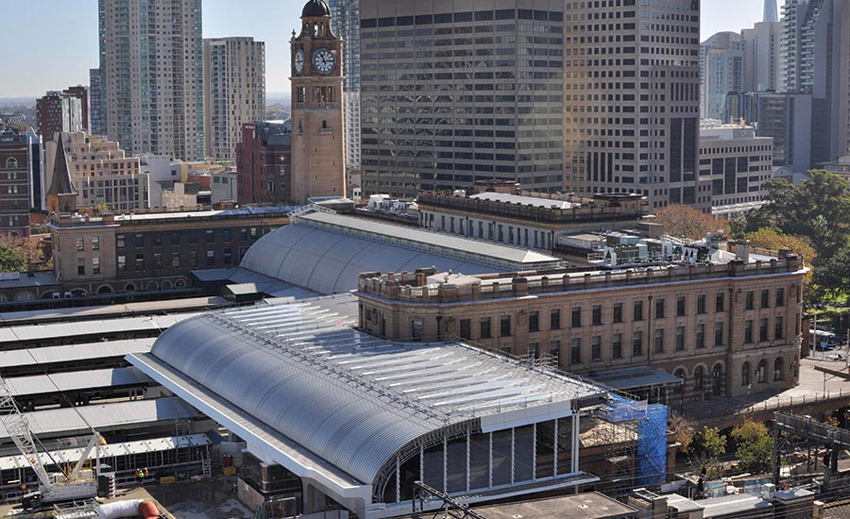
IMAGES: © LAING O’ROURKE/SYDNEY METRO
THE NORTHERN Concourse roof carefully engages Central Station’s 1908 building, conforming to international reversibility standards for adaptive reuse.
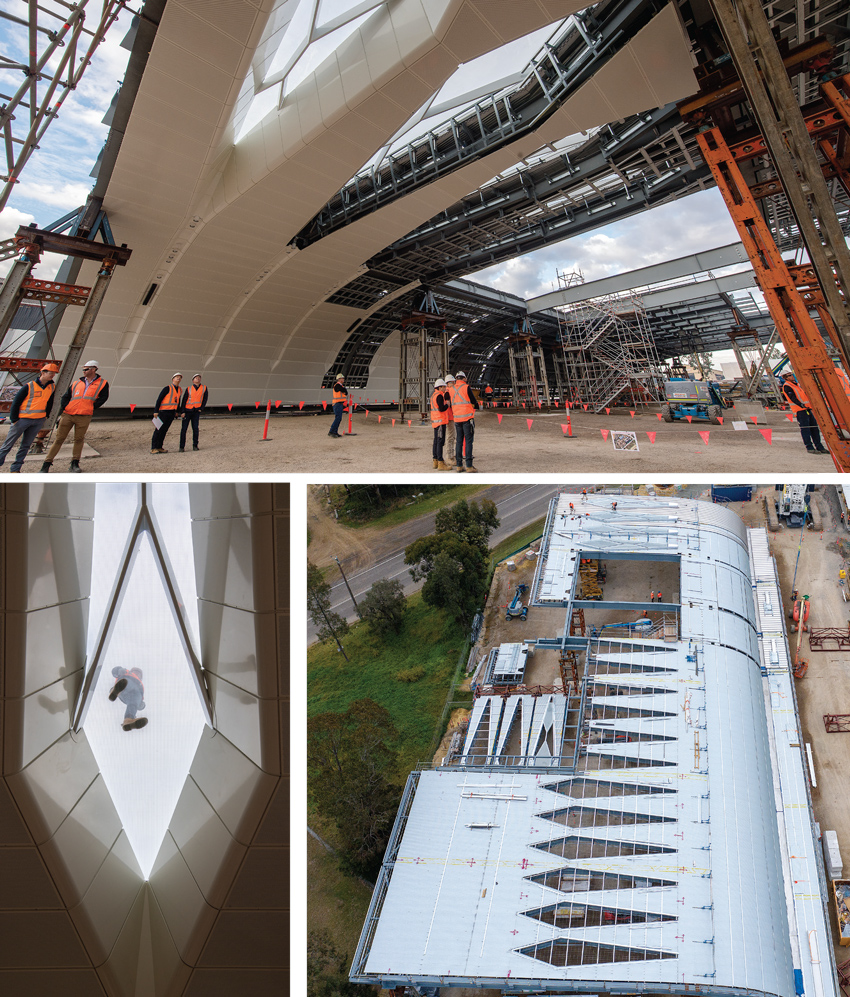
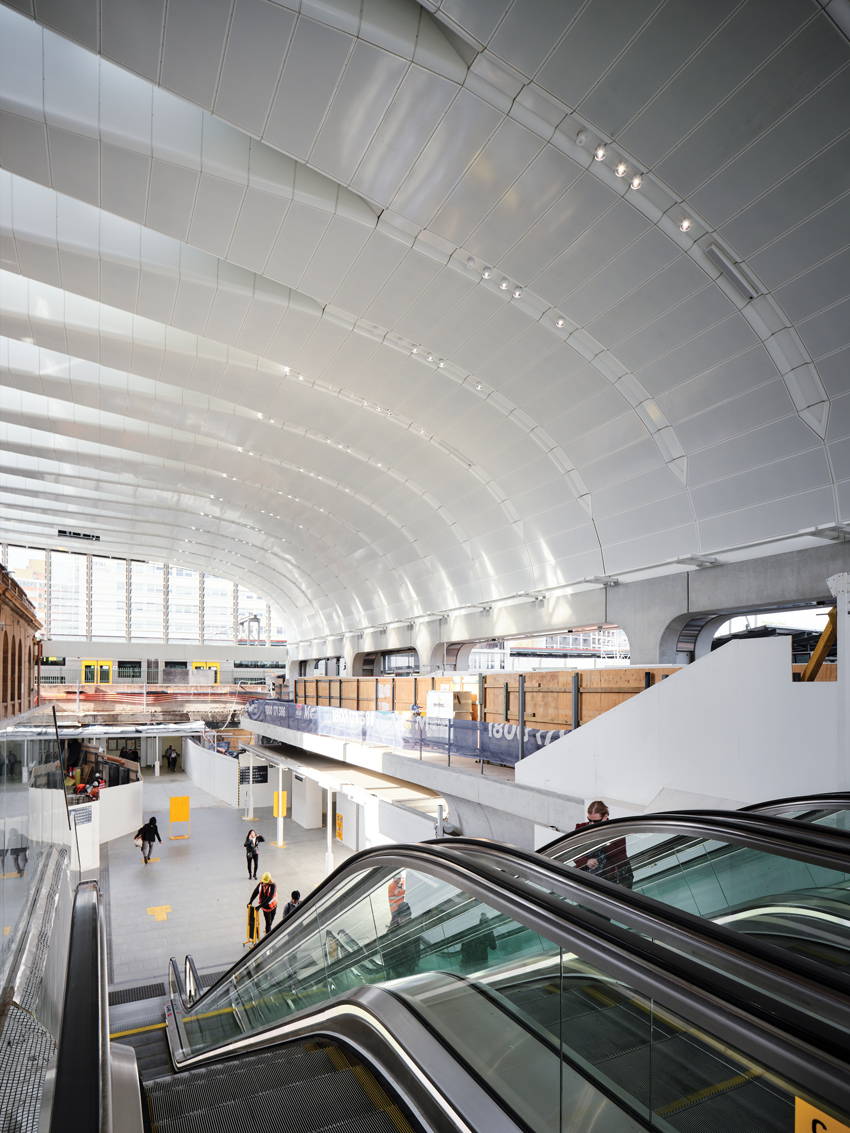
IMAGES: WOODS BAGOT AND JOHN MCASLAN + PARTNERS
In connectivity terms, it was a start. But the problem of Central remained. The old station, designed by New South Wales government architect Walter Liberty Vernon (one of the few architects to support Walter Burley Griffin against the bureaucratic dilution of the latter’s prizewinning plan for Canberra) was a grand and much beloved sandstone job, with a vaulted hall and double-storey loggia running the full 500-foot-long street frontage. Catering to over 270,000 passengers a day makes it busier than London’s King’s Cross and St. Pancras combined.
The new architects were accustomed to complexity. Woods Bagot had already designed the award-winning Wynyard Walk, a pedestrian tunnel linking Wynyard Station, in downtown Sydney, to the vast Richard Rogers, Wilkinson Eyre, and Renzo Piano–designed Barangaroo residential and commercial tower development downtown. JMP had designed the 2012 pre-Olympic revamp of London’s King’s Cross station (RECORD, June 2012). The result, says McAslan, shows “the richness of what can happen when you work with, not against, what exists.”
The project has three main elements: the long north–south metro platforms, 80 feet beneath two existing intercity rail platforms; the east–west Central Walk that links to these from a new, eastern street entrance; and the lofty new “urban room,” known as the Northern Concourse, that mediates between the new metro station and the old sandstone building.
It sounds simple and, to the design team’s credit, the resulting project, though still only half complete, feels quite simple to the user.
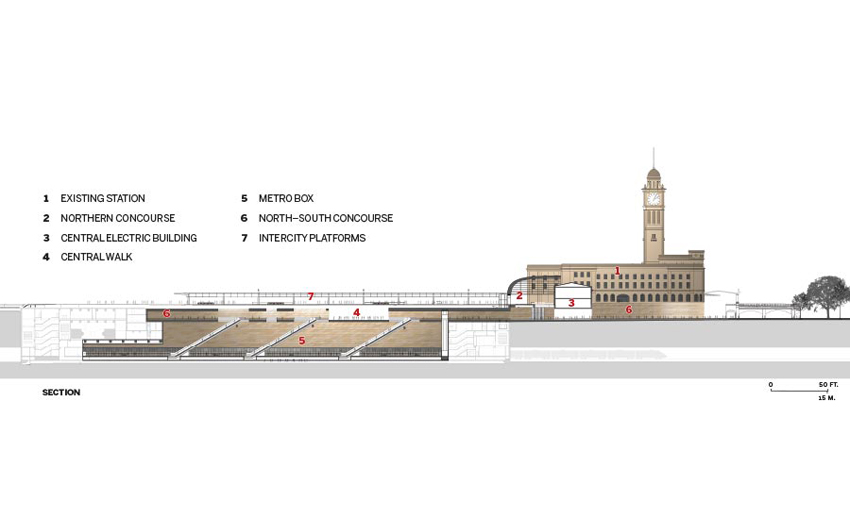
PHOTOGRAPHY: © CTH BOWEN | RUSTY GOAT MEDIA
THE TRUSS-SUPPORTED Northern Concourse roof was assembled first off-site in Kurri Kurri, before being taken apart to be transported to the city.
Lead structural engineer Tony Lavorato from AGJV, the project-specific joint venture of engineering firms GHD and Aurecon, says it has been “very challenging” but extremely rewarding. That the result so closely resembles the earliest conceptual sketches is, he says, testament to the close collaboration, from the competition stage, among the engineers, contractors, and architects.
There were many challenges. For example, the immense 80-foot-deep trench that holds the “metro-box,” or subway tunnel, had already been excavated into rock, under an entirely separate contract. Within it, incoming trains and platforms had to be suspended. The project team also had to accommodate a sewer line, an existing pedestrian tunnel, and the 62-foot-wide Central Walk above the metro. When this trench proved too narrow for supporting columns, an ingenious strut-and-tie system was invented, propping 43-inch-square diagonal struts against the rock face.
Similarly, when the work revealed the handsome century-old Central Electric building that had been hidden by accumulated station works behind the grand old station, it was decided to retain and renovate the building as one wall of the new space. Because level differences meant exposing the building’s foundations, however, it had to be safely underpinned with an entire new understory. This, in allowing pedestrian movement through a grand new stone-clad arch from the street, transforms a dour dungeon space into a light-filled crossing.

PHOTOGRAPHY: MARTIN SIEGNER/FRMEZ
What remains unchanged from those early freehand sketches was the great roof of the new station, which cantilevers 115 feet. This roof, comprising hockey stick–shaped steel trusses, clad with perforated white aluminum and fritted glass, was assembled off-site in Kurri Kurri, 100 miles north of the city, checked to be sure everything worked, and then disassembled for transport to Sydney. And work it does, sailing delicately above the heritage-listed Grand Concourse, Central Electric, and Stationmaster’s buildings.
This creates an airy transitional space and obviates the usual avalanche of wayfinding signage, providing easy visual links to streets and trains and suggesting the possibility of a new rooftop bar, all while upholding international standards for reversibility in adaptive reuse.
Already, though the metro doesn’t open for three years, this lofty and light-filled Northern Concourse is a pleasure to use. For me, it also offers a metaphor that points to even greater potential: unblocking Sydney’s congested heart. With new pedestrian connections east, north, and through to the old station, this project eases and enriches Sydney’s walking experience.
And there is even more promise. Sydney, naturally rich with spatial drama and surprise, is a great pedestrian city. Three further extensions to the Central project would greatly enhance this delight. They include extending Central Walk west, through to the proposed Atlassian tower (by SHoP architects with Sydney’s BVN); extending Prince Alfred Park to the station’s south across the rail tracks and encircling the park with buildings; and extending north, through the old station’s lower loggia to a revamped Belmore Park.
The current Metro project effectively installs a stent in Sydney’s sclerotic heart. These two further thoroughfares, in linking street to street and park to park, would triple that effect. Covid has prioritized walking as a transport mode in its own right; recognizing this, the new connections would let Sydney’s freewheeling pedestrian life percolate throughout.
Elizabeth Farrelly is a columnist for The Sydney Morning Herald. Her latest book is Killing Sydney: The Fight for a City’s Soul (2021).
Credits
Architects: Woods Bagot and John McAslan + Partners
Consultants: AGJC (structure, civil, m/e/p, rail); WarringtonFire (fire); Wilkinson Murray (acoustics); Taylor Thomson Witting (facades); Steensen Varming (lighting); OCP Architects (heritage); Artefact (indigenous heritage)
General Contractor: Laing O’Rourke
Client: Laing O’Rourke for Sydney Metro
Size: 238,000 square feet
Cost: $716 million
Completion date: December 2022 (operational, 2024)
Sources
Curtain Wall: Alfabs
Metal roofing: Kingspan windows and Skylights: JML-Craft
Precast-Concrete Cladding: SA Precast
GRC cladding: Stone Alliance sandstone cladding: Stone Mason & Artist
Terrazzo tile: BetterTiles Elevators/escalators: TK Elevator
ESTABLISHED MORE than a decade ago, the Colorado Building Workshop, a design-build program at the College of Architecture and Planning at the University of Colorado Denver (CU Denver), has won numerous AIA awards for work that demonstrates the innovative use of common building materials. Led by architect and assistant professor Erik (Rick) Sommerfeld, its portfolio includes housing on the Navajo Nation, cabins for the Colorado Outward Bound School, and what may be the best-looking outhouses in the United States—four steel-and-stone privies that appear to emerge from the rugged landscape on the Longs Peak trail in Rocky Mountain National Park.
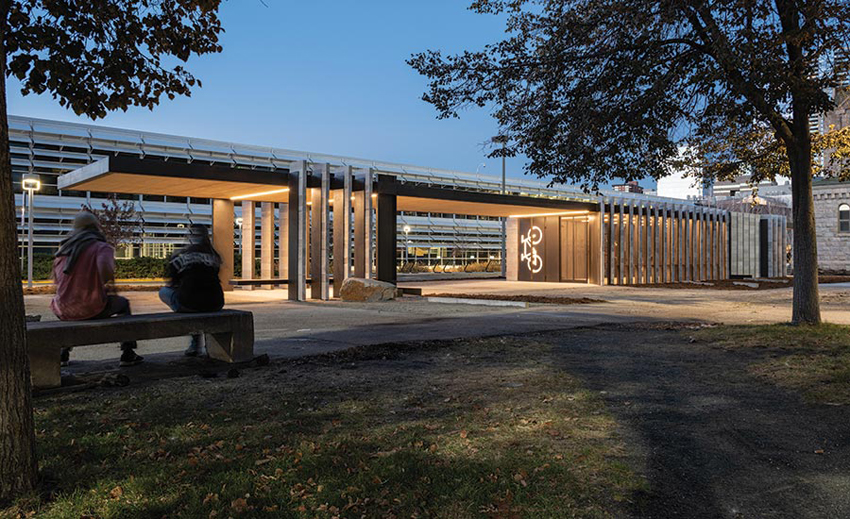

ALL PHOTOGRAPHY BY JESSE KUROIWA
A Pavilion at Curtis Street offers secure bike storage.
The graduate-level workshop’s latest project is closer to home. Completed during the pandemic, the Auraria Bike Pavilions are located in downtown Denver, on the campus of the Auraria Higher Education Center, home to CU Denver, Metropolitan State University, and the Community College of Denver.
The project began in 2019, when Chris Herr, sustainability officer for Auraria’s Sustainable Campus Program, approached Sommerfeld about designing a pair of bicycle-storage facilities for the mostly-commuter campus. Getting around on two wheels is already popular, but Herr wanted to encourage even more nonmotorized transportation, while also combating bike theft, which is rampant on the campus. (Ironically, a bike belonging to one of Sommerfeld’s students was stolen on the very first day of construction.)
Working in teams, the workshop’s 25 students met often (but virtually) with the client and eventually arrived at a simple yet elegant design for the pavilions, which are located near high-use buildings on campus. Each is constructed with louvered walls made of limestone and steel mesh. The plan allows daylight to enter the buildings from the sides, while also permitting users to peer in to see if there are available spaces for bikes. A flat, 4-inch-thick cross-laminated timber roof spans the 16-foot width of both structures.
At the entrance of each pavilion, a graphic image of a hanging bicycle makes clear what the buildings are for. The facilities, accessed by registered users with key cards, hold 50 bicycles apiece and a few skateboards, and contain fix-it stations with tools and pumps.
The workshop students used Tally, a Revit plug-in developed by architecture firm KieranTimberlake, to assess the pavilions’ environmental impact. “It helped guide our decision to use cross-laminated timber [CLT] for the roofs instead of traditional framing,” Sommerfeld says. The buildings aren’t exactly temporary, but they were designed to be easily disassembled and the materials recycled if they ever become obsolete or need to be replaced with other structures. For that reason, the limestone blocks are dry-stacked and the CLT panels unmodified.
The students, wearing masks and working with building professionals, began construction last August. “Very few of them had experience,” Sommerfeld says, “but the advantage of doing small buildings is that they’re not overly complicated. We’re not trying to make the students into builders but rather to have an appreciation for people that they’ll be working with.”
Recent graduate Cecilia Richey, who had previously done a few DIY projects around the house, found herself lifting 40-pound limestone blocks and learning how to weld. “The workshop was the highlight of the master’s program,” she says. “You learn much more by doing than by just drawing.”
Herr, who’s had two bikes stolen from the Auraria campus, is thrilled with the pavilions. “I think they look amazing,” he says. “They’re better than anything I could have imagined.” He expects them to get plenty of use starting this month, when students return to the campus (largely empty during the pandemic). He’s already fielding inquiries about them. “Hopefully, they’ll encourage more students to commute on bikes. That’s the idea.”
Denver-based journalist David Hill writes about architecture, design, and urban planning.
Credits
Architect: Colorado Building Workshop — Will Koning, Šárka Malošíková, Paul Stockhoff, design team
Engineers: Andy Paddock (structural); AE Design (electrical)
General Contractor: Colorado Building Workshop
Consultants: Design Workshop (landscape); MH Companies (lighting); TMW Stonemasons (stone); Front Range Roofing (roofs); Justin Morse, Ricky Ludeman (welding); RAW Creative (fabrication); Ellis Construction, Brannan Concrete, Brundage Bone (concrete)
Client: Auraria Sustainable Campus Program
Owner: Auraria Higher Education Center (AHEC)
Size: 3,000 square feet
Cost: $200,000
Completion date: November 2020
Sources
Masonry: Indiana Limestone
Perforated Metal Panels: Peterson
Cross-Laminated Timber: SmartLam
Roofing: Carlisle
Fasteners: Simpson Strong Tie
Pivot Hinges: FritzJurgens
Coatings: Tnemec
Lighting: Beulux; Hubbell; Wattstopper Building Software: Tally
IT IS WITH pride that Ondřej Chybík reveals he has no driver’s license, and his partner, Michal Krištof, has only recently obtained one. The architects are cofounders of the Czech Republic–based Chybík+Krištof, a 2019 Record Design Vanguard firm, and, Chybík explains, they find that experiencing as many aspects of a city as possible, even (or especially) poor public transportation infrastructure, is essential to their practice. Born in Brno, the country’s second-largest city, both of them were well acquainted with Zvonařka Central Bus Terminal, which makes more than 820 regional, national, and international connections and serves approximately 17,000 passengers each day. In spite of its central location and critical role in the city’s infrastructure, the Brno municipality lost control of the terminal when it was privatized in the 1990s, and it subsequently fell into disrepair. “Zvonařka seemed a dark, unfriendly place,” says the city’s mayor, Markéta Vaňková. A frequent bus rider, Chybík agrees: “It was really the worst place in the city.”
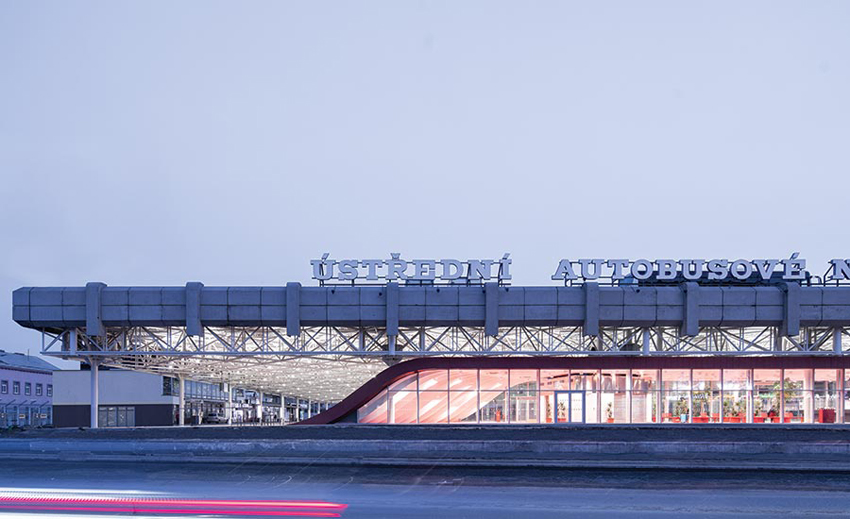
ALL PHOTOGRAPHY BY ALEXANDRA TIMPAU
THE WAVELIKE new passenger hall gives the restored terminal a prominent entry from the street.
Chybík and Krištof see themselves as activist architects, with a history of seeking out projects that will have social impact. They set out to learn what it would take to rehabilitate the 1980s terminal, a steel column and space frame structure, encircled by a parapet of reinforced precast concrete, designed by architect Radúz Russ. The private entity that rented the terminal’s platforms to bus providers, it turned out, did not make enough money to maintain or renovate the building, but, during a nearly five-year advocacy process, the architects helped secure public funding to finance the terminal’s rehabilitation before taking on the project as designers in 2018.
Chybík+Krištof is part of a growing movement to preserve Brutalist-era structures, in hope of saving them from the fate of the now-demolished Hotel Praha and Transgas buildings in Prague. While the Zvonařka terminal is recognized as a Brutalist heritage site, years of neglect and poor add-ons had obscured its architectural pedigree. “There was a lack of light, and the entire space was full of temporary stands with no architectural quality,” says Chybík. After the building—at 107,650 square feet, larger than Brno’s central city square—was emptied of all but its steel columns, and repainted bright white, the architects reconfigured the plan to make it more transparent and accessible. Now the terminal’s vast main hall has uninterrupted pathways and sight lines to signage for arrivals and departures, with an inner space for each bus platform. From the time it was built, up to 100 buses could park on the terminal’s roof—hence its robust structure. The architects were able to add 50 “park-and-ride” spaces while retaining the same capacity for buses, and also a new elevator to connect the parking area with the platforms below. A new passenger hall opens to a very visible entrance on Zvonařka Street, opposite a major shopping center. The hall’s wavelike glass, steel, and concrete form contrasts with the angularity of the original structure and enhances wayfinding. Passenger walkways now flow into the hall clearly from city streets, eliminating a formerly circuitous route.
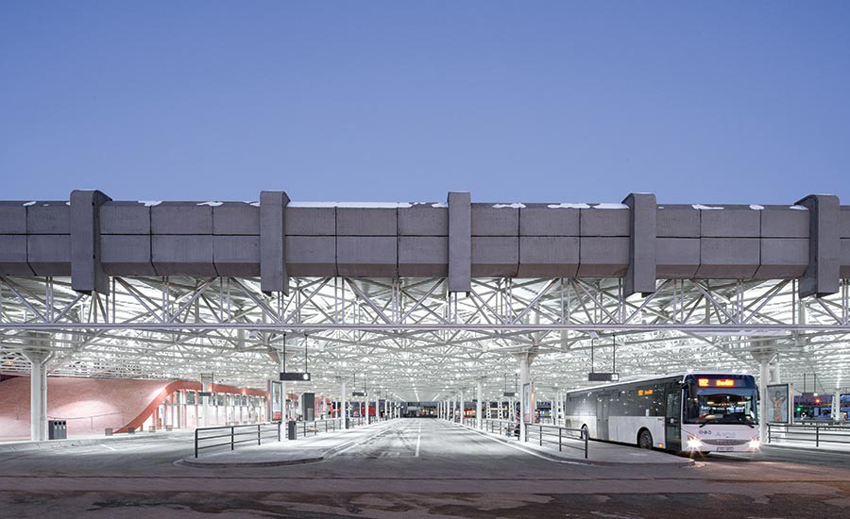
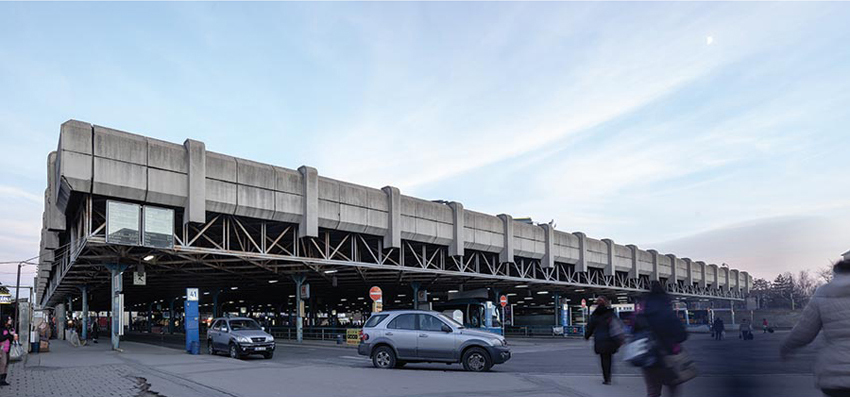
The terminal before renovation
Lighting is crucial to the modernized terminal: “It was project-specific, because the beauty of the steel structure is key,” says Chybík. “We hung the lighting on the steel structure to illuminate it upward, so the structure appears to be floating above the platforms.” The terminal’s original curved skylight, which bisects the roof, was restored to bring in more natural light.
Yet to be completed is a publicly owned entrance plaza, between the building and the roadway. Chybík and Krištof see the station and that surrounding plaza as an essential urban gathering place, and they interviewed many of its users, including homeless people who had called its benches their own for years. “They considered some public spaces we didn’t even see,” says Chybík.
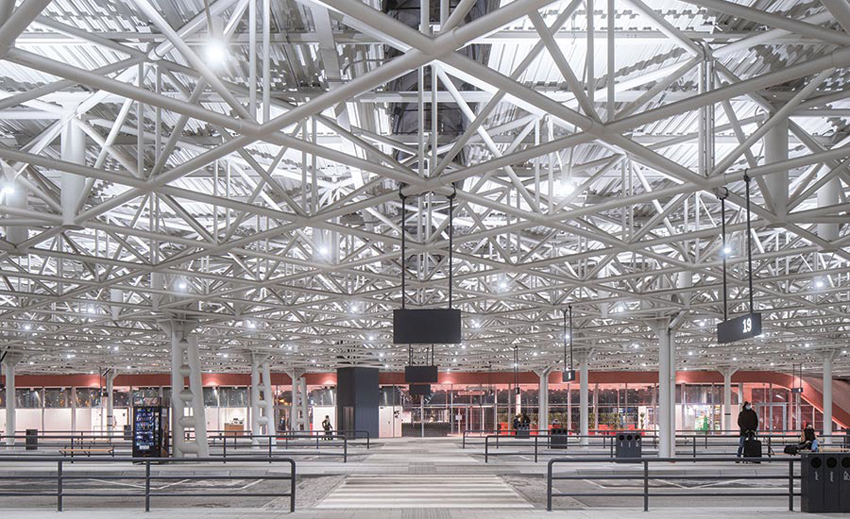
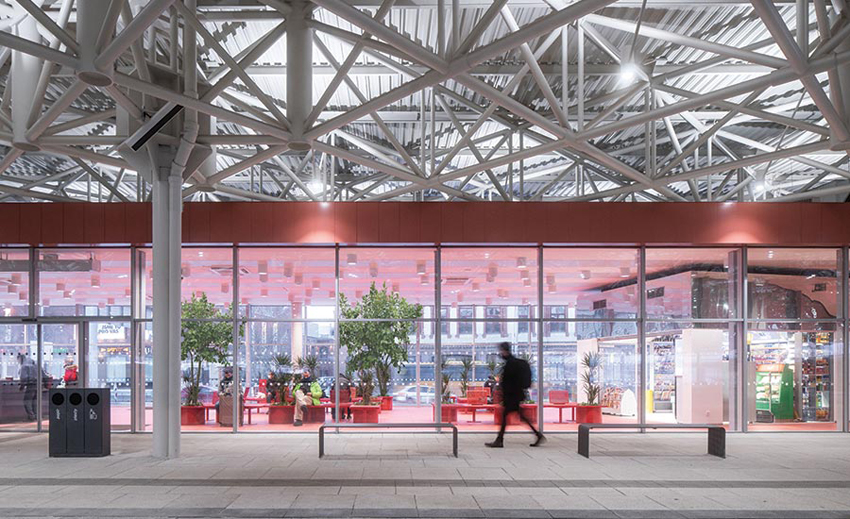
The terminal after renovation
Now the city has added a new tram line to the terminal. “The part of the city where Zvonařka is located has seen considerable development recently,” says Mayor Vaňková. “The area has a huge industrial heritage and now is turning to new purposes.” Nearby is the reconstruction of Mendel Square, a busy hub next to the monastery where Johann Gregor Mendel discovered the principles of genetics in the 1860s, and where Chybík+Krištof are designing a reimagined version of Mendel’s greenhouse.
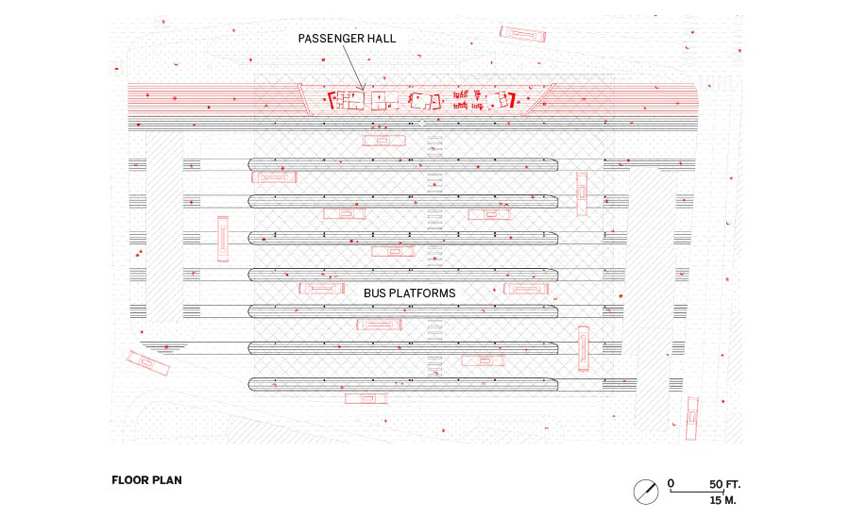
But the architects say the city’s transportation infrastructure is far from saved: an ongoing architecture competition for a new train station to be built outside the city’s center would erode the street life that adds energy to Brno’s core. But there’s hope that the existing 130-year-old station can remain in use as a vital part of the city. If the architects could spend close to a decade shepherding the bus terminal toward renewal, they may do the same for more of Brno’s other transportation buildings as well.
Jennifer Krichels is a Brooklyn-based writer.
Credits
Architect: Chybík+Krištof Architects & Urban Designers
Engineers: ENGIE Services (electrical); Jan Kašpar (traffic)
General Contractor: PS Brno
Consultants: K4 (lighting); RIDE Technic (ceiling systems)
Client: ČSAD Brno Holding
Size: 107,650 square feet
Cost: $5.5 million
Completion date: December 2020
Sources
Paint: Hempel
Hardware: Bustec
TOPPED BY a monolithic undulating roof, the Takanawa Gateway Station recalls the elegance of the historic European train station—but in the heart of Tokyo. Designed by Kengo Kuma, the building is the first addition in 50 years to the Yamanote Line, the famous elevated train encircling the city center. Also serving the Keihin-Tohoku suburban commuter railway, the building is poised to become a main access point for a 32-acre urban-renewal project spearheaded by the station client, East Japan Railway Company. Titled Global Gateway Shinagawa, the phased development (master-planned by New Haven firm Pickard Chilton) is intended to transform a trainyard into an international business center and is slated for completion in 2040.
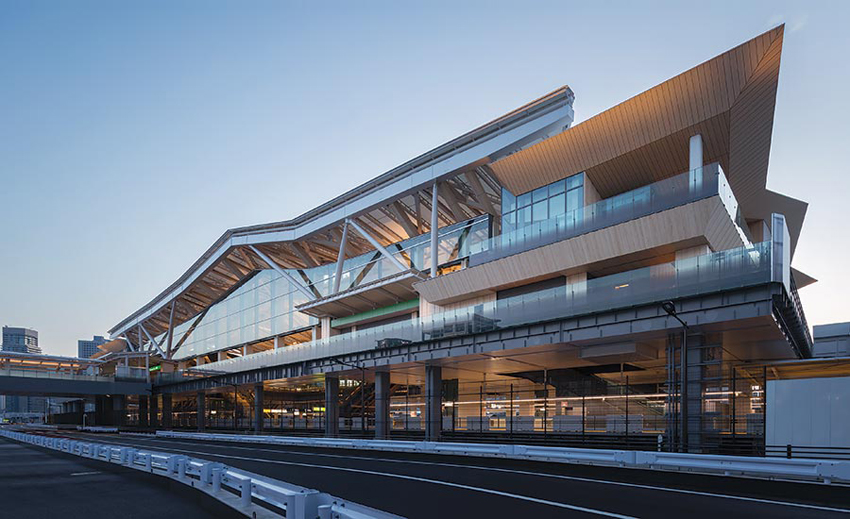
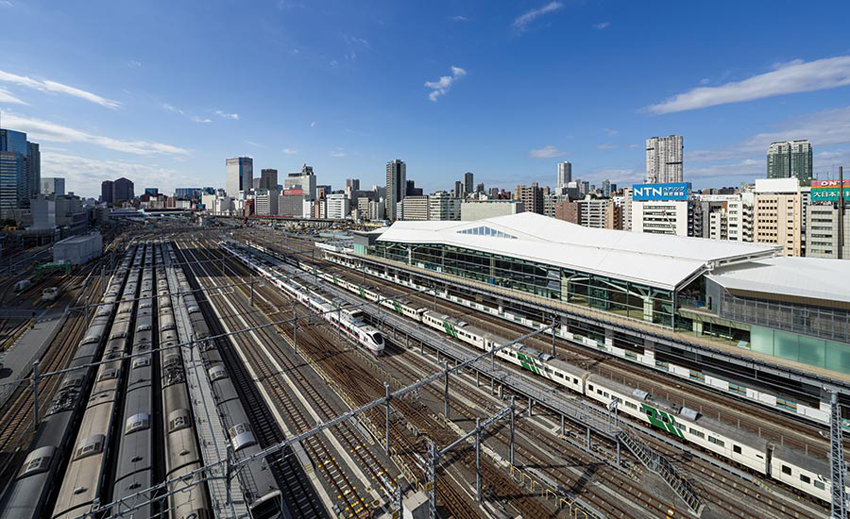
PHOTOGRAPHY: © EAST JAPAN RAILWAY COMPANY
THE ROOF surfaces—resembling shoji, folded like origami—and abundant use of wood, underscore the building’s Japaneseness (top and bottom).
Passengers arriving at the station from Dai-ichi Keihin, a key multilane thoroughfare, ascend stairs and traverse a partially covered walkway to enter the concourse, a soaring space extending to the roof. This level includes the station office and restrooms at its north end, while its south end will hold a second entrance when the redevelopment project is finished. Connecting to a pedestrian deck, the additional entrance will also enable passengers to walk to Shinagawa Station, a nearby major transportation hub and Bullet-train stop. Beneath the concourse level are platforms for the four sets of train tracks while, above, balconies flank either end of the linear space, providing places to look down at the hustle and bustle. The entire interior is united by an enormous atrium at the building’s center, which rises up from the tracks to the ceiling and enables air and daylight to flow from top to bottom. Gazing up from the platform, the eye is filled with views of the roof underpinnings and soft light from above. “As they did with 19th-century terminals, we wanted to make one large space,” explains Kengo Kuma.
This idea of a singular voluminous space is underscored by the roof, whose hovering white planes unify the station. Its shoji-like white surface is composed of translucent PTFE-coated glass-fiber sheets arranged in four 394-foot-long ribbons. Inspired by origami paper, each strip is delicately creased with a series of “mountain” and “valley” folds. Where the folds do not align, there are vertical gaps between strips that, filled with panels of transparent ETFE plastic, function as clerestories. “I wanted to see the sky from the station,” says Kuma. The architect also wanted the building to “breathe,” a feat achieved by inserting a 7-foot gap between the roof and the curtain wall. While deep eaves prevent rain from entering the building, these gaps provide sufficient natural ventilation to eliminate the need for mechanical air-conditioning except in the lavatories and other enclosed areas. The transparent outer walls, made of floor-to-ceiling glass secured in steel frames, enable a strong visual connection between the station interior and the surrounding neighborhood—especially at night, when uplighting illuminates the roof and the building glows, in the words of Kuma, like a chochin lantern.
Integrated within the curtain wall are wood-clad steel columns supporting the roof perimeter. In the concourse, the roof is held up by eight more columns, tree-shaped and strategically located to impede pedestrian traffic as little as possible. Also made of wood-clad steel, these members’ 5-foot-square trunk-like bases are topped with steel tubes that radiate outward, resembling branches. High-tension bolts join the roof structure’s wood and steel, ensuring their tight connection even when trains come rumbling through below.
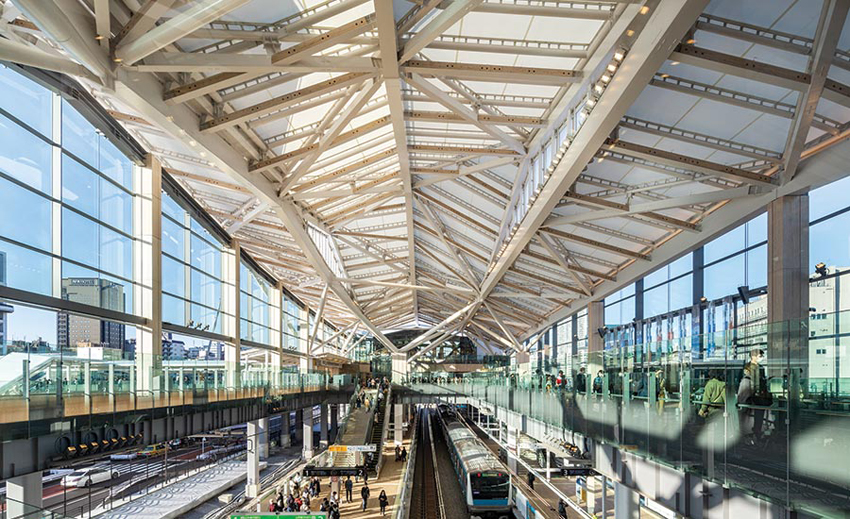
FLOOR-TO-CEILING glass connects passengers to the outside and makes the roof appear as a floating canopy.
Kuma used a similar hybrid system for the roof trusses in the Japan National Stadium, built for the 2020 Tokyo Olympics. In many ways, wood, the medium of traditional Japanese architecture, is Kuma’s signature. He has used it across the country in museums, municipal centers, academic buildings, and other projects not regularly associated with timber construction. “In the station, we used wood everywhere to let visitors feel the Japanese space,” he explains. Like the structural components, the interior soffits are clad with cedar from Fukushima Prefecture. For fire protection and ease of maintenance, many of the wood elements were treated with a fire-proof glass coating and tinged with white paint to match the roof, while letting the grain show through. Outside, where the material also needed to be able to withstand water exposure, engineered New Zealand pine was used for wall cladding beneath the roof. Even the platform’s tiled floor has a woodgrain pattern. Unexpected in a heavily trafficked transportation hub through which 130,000 passengers will eventually pass every day, the wood softens the hard surfaces and cold metallics typical of station buildings.


THE ROOF STRUCTURE is visible throughout the station (top images) and, at night, from afar (bottom), as the building glows like a lantern.
The use of wood is especially evident on the platform level in the Kuma-designed bentwood benches and hip-height bars that passengers can lean against while waiting for their train. Manufactured in Yamagata Prefecture by Tendo Co. Ltd, the venerated furniture factory that first produced Sori Yanagi’s Butterfly Stool, both seating elements are made of molded cedar plywood, and their curving forms are as easy on the eye as they are on the body.
Between the presence of wood and the origami-like roof, with its reference to lanterns, the Takanawa Gateway Station bows politely to traditional Japan. Its individual components are employed with the refinement, grace, and exquisite craftsmanship we have come to expect of a Kengo Kuma building. Rendered at a large scale and with a high degree of abstraction, the station’s Japaneseness is legible but without being kitsch or commercial.
Credits
Architect: Kengo Kuma and Associates — Minoru Yokoo, Keita Watanabe, Yokoi Tomoyuki, Kimio Suzuki, Yuzuru Kamiya, Go Terasawa, Hisako Tokai, Atsushi Kawanishi*, Takumi Nakahara*, Minako Izumi* (*former staff)
Architect of Record & Engineers: East Japan Railway Company + JR East Design Corporation
Consultant: LPA (lighting)
General Contractors: Obayashi Corporation + Tekken Corporation
Client: East Japan Railway Company
Size: 68,245 square feet
Cost: withheld
Completion date: March 2020
Sources
Roofing/Skylights: Taiyo Kogyo Corporation (PTFE & ETFE)
Elevators/Escalators: Hitachi
“IF YOU DIG a hole in New York City, it costs a million dollars and generates a million meetings,” jokes Mark Yoes, design principal at WXY. The design process for the Robert R. Douglass pedestrian bridge, which crosses West Street in lower Manhattan, backs up his point. Seven years and $45 million later, just before the 20th anniversary of 9/11, WXY has completed the last piece of the Lower Manhattan Development Corporation’s (LMDC) plan for rebuilding and restoring the area below Houston Street affected by the destruction of the World Trade Center towers. For the New York–based architects, the 240-foot-long walkway bookends two decades of work—the firm also helped with LMDC’s first project, restoring the Battery Park City esplanade and assisting with the disaster-recovery plan in 2001. “Now people can cross the bridge and not think about any of those things,” says Claire Weisz, principal in charge at WXY.
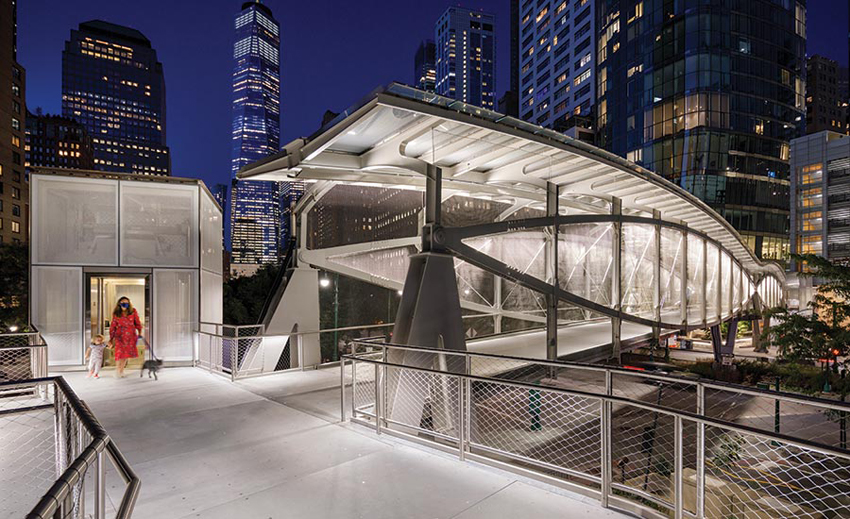
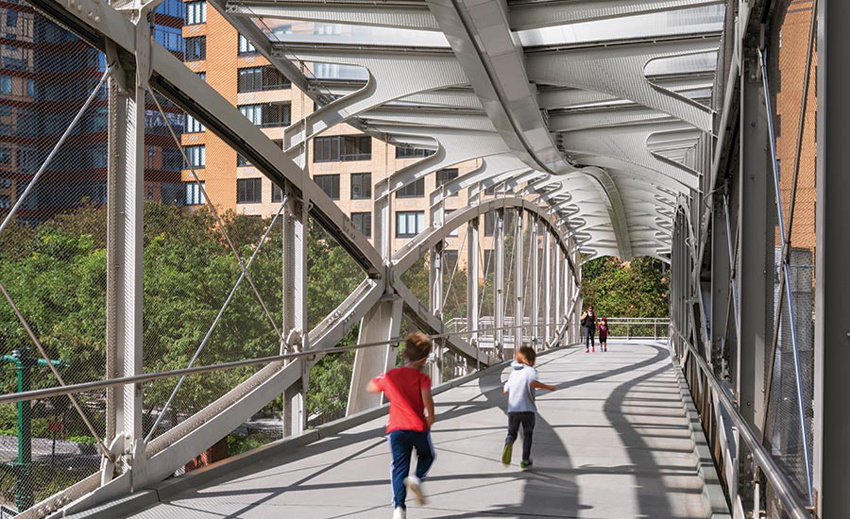
All Photography by Albert Vecerka/Esto
CONNECTING the Financial District to Battery Park City, both bridge approaches are accessible by stair and elevator and are illuminated by LEDs (top and bottom).
Named for Robert R. Douglass, the late LMDC board member who led post-9/11 efforts in Manhattan, the new structure replaces SHoP Architects’ interim Rector Street footbridge one block north. “It was very controversial,” says Weisz. “Even though Rector Street was a temporary bridge that was built to be dismantled and recycled, people wanted it up.” And although it became a neighborhood fixture over the years, a replacement—by WXY—was still needed, as it wasn’t built to last.
Working with the New York City Economic Development Corporation (NYEDC) on a project funded entirely by LMDC’s federal funds meant the architects needed to adhere to extra layers of rules and regulations. (Both NYEDC and LMDC are clients of the architects, though the Battery Park City Authority maintains the bridge). For example, WXY had to ensure that the structure’s steel was American-made, per the FTC’s Buy America program. Fabricated in steel shops in upstate New York and in Pennsylvania, the bridge was assembled off-site, stored in Brooklyn’s Red Hook neighborhood, and delivered to the downtown water’s edge by barge. It was then hoisted over the Battery Park City esplanade by crane. “The need to assemble it quickly was a major driver of the whole design,” says Yoes. For two nights in a single weekend, traffic on West Street was closed for 20-minute increments while the bridge was erected.
For this reason, it was especially important that the materials were lightweight for efficiency and ease of transport, according to Courtney Clark, associate principal at Thornton Tomasetti, the structural engineers. “We didn’t have room for a big foundation,” Clark says, explaining why the team created a lightweight superstructure of steel trusses and a fiber-reinforced plastic deck. The distinctive curved lenticular truss design and its spans—there are two, due to weight—are supported by three individual steel buttresses. According to Clark, the bridge’s central pier, in the road median, misses the Brooklyn-Battery Tunnel “by a few feet,” and the eastern end is constrained by underground utility lines, hence requiring a larger west footprint with an A-framed pier.
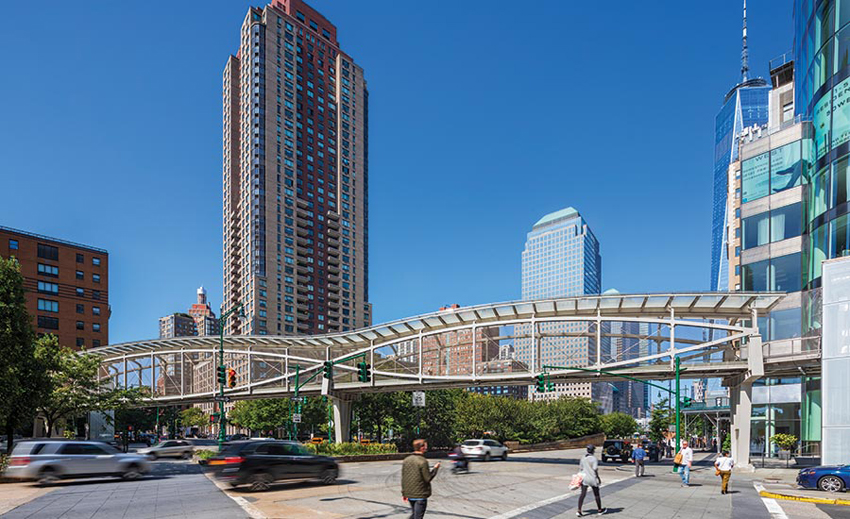
THE LENTICULAR truss bridge satisfies the need for a lightweight structure and boldly spans the multilane West Street.
Across both spans, a glass roof with convex steel supports provides lateral bracing and shields people from the elements while still admitting daylight to the passageway below. Along the elevated path, diamond steel mesh is used as fencing—to prevent jumping or falling—while allowing for air movement and a sense of openness. “With infrastructure, it’s important to look at codes as a warning, but not as something to design to,” says Weisz. Above the traffic and several blocks from the water, the gentle sea breeze and shaded walkway are a welcome respite from the heat and create a low-energy microclimate for comfortable crossing. (Though in the winter, the gusts may be less refreshing.)
“There are two goals when you do a public-space project,” says Weisz. “You want to make what’s already there look better, and you want it to feel as if it was always there.” From above West Street, there’s a good chance the professionals who work in the Financial District and the families who live in Battery Park City will focus on the whoosh of the cars below, the dramatic shadows cast by the arched steel roof supports, and the stellar view of One World Trade Center to the north. It’s impossible to ignore how the skyline has changed, but easy to forget the bridge hasn’t always been there.
Credits
Architect: WXY architecture + urban design
Engineers: Thornton Tomasetti (structural), Wesler-Cohen Associates (mechanical)
General Contractor: Skansa
Consultants: NV5 (landscape architecture), FRONT (facade), ARUP (lighting)
Clients: New York City Economic Development Corporation, Battery Park City Authority, and the Lower Manhattan Development Corporation
Size: 240 feet long
Cost: $45 million
Completion date: 2020
Sources
Glazing: Prelco Glass
Lighting: Ecosense (wall wash lights), Axis Lighting (stairs & handrails)
Cladding: Sherwin-Williams (steel paint), Jakob (cable mesh), Composite Advantage (fiber-reinforced



















